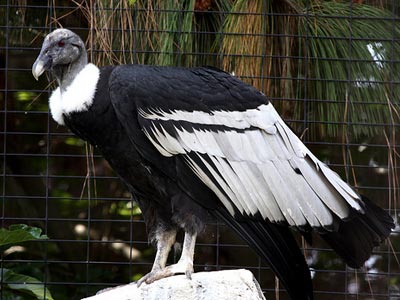Get to know about Andean Condor, their habitat and diet, read out these interesting Andean Condor Facts. The Andean Condor (Vultur gryphus) is the largest representative of the six species of South American vultures in the carrion-eating family known as Carthatidae. These birds are normally found in the Andes Mountains and western South America. The base of the neck is bordered by the white feathers and is commonly notable in male species. There are white blotches on its wings. As in other vultures, the Andean condor exhibits naked head and neck. The color of the neck and head alters according the birds’ mood. The size of the female is smaller as compared to the males. With a predominant nature of scavenger, Andean condor feeds on carrion, deer and cattle. It is by far one of the largest and longest-lived birds with a lifespan of about 100 years in captivity.
Andean Condor Facts
- The California condor is slightly greater as compared to the Andean condor in that the difference is only 7 – 8 cm.
- The wingspan ranges from 270 to 320 cm (8.9 to 10.5 ft).
- The males generally weigh around 11 to 15 kg (24 to 33l lb), with the weight of the females is about 8 to 11 kg (18 to 24 lb). The average weight is 11.3 kg (25 lb).
- The length of Andean condor measures around 10 to 130 cm (39 to 51 inches).
- The head and the neck are reddish-brown in color and are enclosed by the ruff of white feathers.
- The middle toe is stretched out as compared to one at the back. These birds use their feet more frequently for walking instead of killing their prey.
- With their hooked beak they are qualified enough to tear any prey that comes under its talons.
Read More: Andean Condor Facts
Where Do Andean Condors Live
Basically known to reside in the mountainous range of South America including Andes Mountains and Santa Marta Mountains. They are also the inhabitants of Columbia, Venezuela, with some species inhabiting in Chile, Bolivia, Argentine, Peru, Ecuador, and Tierra del Feugo. The population of Andean condor faced a dramatic decline since the beginning of the 19th century. This is mainly due to the human’s activities. These types of condors inhabit in open grasslands and are known to live at an elevation of about 5,000 m (16,000 feet). Though rarely, these species are also found in the lowland desert areas of eastern Bolivia and Brazil.
What Do Andean Condors Eat
As mentioned earlier, these birds are scavengers by nature and they primarily feed on carrion. They are known to travel vast distances of about 200 km (120 miles) in quest of carrion. However, these species also feed on large cadavers such as deer and farm animals. They locate dead animals by the gas which emits through their dead bodies. They are capable to go by quite a number of days without food.
Andean Condor Facts | Reproduction
- These condors become mature after 5 to 6 years of age.
- They are known to live up to 50 years or more in the wild. However, under captivity they can survive up to 100 years.
- Being monogamous by nature, these condors mate for life.
- Andean condors preferably roost at an elevation of about 3,000 to 5,000 (9,800 to 16,000 feet).
- The clutch size comprises 1 to 2 bluish eggs. These eggs weigh around 280 grams (9.9 oz), with the length measuring at 75 to 100 mm (3.0 to 3.9 inches).
- The eggs are normally laid in the months of February and March.
- The hatching period lasts for 54 to 58 days. The chicks begin to fly after a period of 180 days.

Leave a Reply